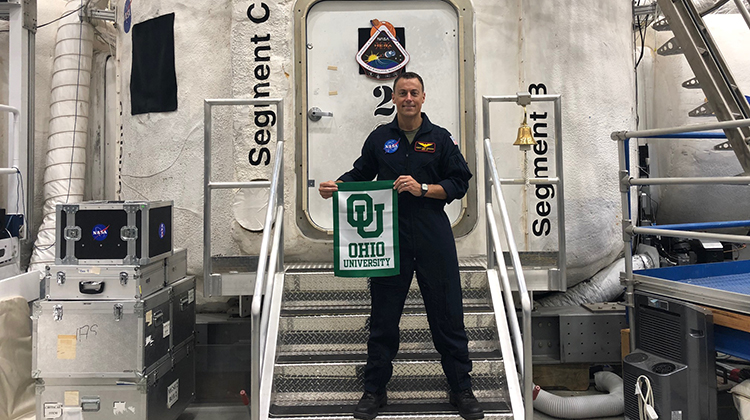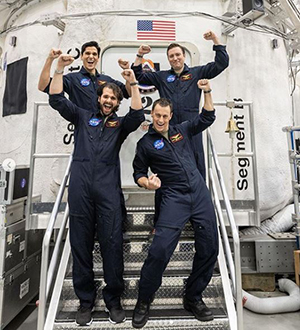OHIO graduate spends 45 days in mock spacecraft for NASA research

Bob Ferguson, BSME ’98, displays a little Bobcat pride outside of NASA’s Human Exploration Research Analog (HERA) habitat, a 636-square-foot mock spacecraft that the Ohio University graduate was confined to for 45 days as part of a NASA HERA research expedition. Photo courtesy of Bob Ferguson
In late September, when most were adjusting to the changing seasons and fall weather, Ohio University alumnus Bob Ferguson, BSME ’98, stepped out into the open air after living with three strangers in a confined habitat for 45 days.
Ferguson and his crewmates were making history, “landing” back on Earth after a simulated mission to Phobos, the largest moon of Mars, as part of NASA’s 20th Human Exploration Research Analog (HERA) research expedition. The ground-based analog, all of which takes place inside NASA’s Johnson Space Center in Houston, challenges four volunteer crew members to live and work inside a mock spacecraft for 45 days – all as a means of studying the effects of isolation and confinement astronauts experience during long-term space expeditions.
Researchers assess the behavior of HERA crew members during these six-week missions and use these observations to better understand human health and communication while in space.
“Someday, I’m hoping that a human steps on the surface of Mars or some other type of planetary surface, and I hope our contribution, however small, will make a difference in that situation,” Ferguson, who resides in Atlanta, said. “Whether it’s about the crew selection or the understanding of crew relationships over such a long duration, I’m very proud to be able to contribute.”
Being a part of NASA’s Human Research Program was a dream come true for Ferguson who has always been interested in science, engineering and space — passions that were fueled as an undergraduate in OHIO’s Fritz J. and Dolores H. Russ College of Engineering and Technology. He went on to earn a master’s degree – a prerequisite to participate in HERA – in engineering at Case Western Reserve University, to become a licensed pilot and today is the vice president of global research and development at Vernay Laboratories Inc.
“I’ve always been interested in human exploration and, specifically, space exploration,” Ferguson said. “As an engineer, I’ve always kept my mind on aerospace and space exploration. It’s kind of a personal hobby for me. I’m interested in all things that fly and always wanted to contribute to that endeavor somehow, whether it be directly at NASA or some other type of human test subject contribution.”
A simple Google search led Ferguson to NASA’s HERA program, which recruits crew members with astronaut-like qualities. Program applicants go through an initial screening process before traveling to the Johnson Space Center for additional screenings and in-person interviews.
“You go through a physical because they have to determine your physiologic capability to withstand the mission,” Ferguson explained. “There’s also some interviews you have to do with a psychologist and do some screenings there to make sure that you’re of sound mind and body.”
After being selected for the HERA XX mission in July, Ferguson was provided the names of the three men who would be joining him on this adventure, and the group scheduled video conferences to begin to acquaint themselves with one another. The HERA XX crew reported for duty at the Johnson Space Center on Aug. 1 for two weeks of pre-mission training – training that NASA astronauts typically spend as much as two years doing in the lead-up to an actual space mission. One of the HERA XX crew’s first assignments was designing their very own mission patch.

Bob Ferguson, BSME ’98, and his three NASA HERA XX crewmates celebrate at NASA’s Johnson Space Center after emerging from the mock spacecraft they were confined to during the research expedition. Photo courtesy of Bob Ferguson
“Once we were on site at Johnson Space Center, we were able to start to spend more time together face-to-face,” Ferguson said. “It was a really pleasurable experience to get to know these guys. All the way through the mission, we were able to even bond closer and become much tighter as a unit.”
The HERA XX mission launched on Aug. 16 when Ferguson and his crewmates entered the 2.5-story habitat, known as “The Hab.” The approximately 636-square-foot metal capsule mimics that of a spaceship with the first floor housing the crew’s workspace, the second floor containing the galley, exercise equipment and a table, and the dome at the top of the facility dedicated to the crew’s sleeping quarters.
“It didn’t bother me that much to be confined in tight quarters with three other crew members,” Ferguson said. “If I did find myself really desiring to step away and get some privacy somewhere, there was enough space even within that small confined area where people could do that if they needed.”
Though the crew kept a close eye on the calendar, Ferguson said the 45 days spent confined in the habitat passed quickly. Each 16-hour day was meticulously scheduled by NASA, which provided the crew a playbook that mapped out their activities for the day. Some of those activities included flight simulations and maintenance exercises.
The crew’s playbook also included weekly family phone calls and “white space.”
“That was our downtime when we could do whatever we wanted – within the confines of the habitat, of course,” Ferguson said.
The crew would spend that time playing board games, reading, or – for Ferguson – playing guitar, which was the one item he brought on board for entertainment.
Ferguson noted that the HERA XX crew operated on one unifying goal: being a high-performing team throughout the mission.
“We had a common interest in performing as well as we could,” he said, adding that as the days went on, this competitive group of men created challenges to spice thing up and keep each other motivated. “I mean, let’s face it, the whole point of this experiment is to try and determine how well a crew performs in confinement and to see if there’s any degradation, in either interaction or cognitive abilities, throughout the duration of the mission.”
The HERA XX crew “landed” on Sept. 30 and exited the habitat to the cheers of family and friends and embarked on a week of post-mission work.
Ferguson and his crewmates continue to keep in touch and are planning for reunions. And while Ferguson’s NASA experience is behind him, the lessons he learned he continues to apply in his personal and professional life.
His time in “The Hab,” Ferguson said, made him more aware of the way emotion and perception can impact a team and its performance.
“Everybody has different experiences in the world,” he said. “That’s what makes a high-performing team so special – the diverse experiences that people bring in their perspective. You have to respect other people’s preferences and know what their expectations are. Then you’re more likely to be successful and be able to perform at a high level and also continue to have positive crew relations.”
Months after the mission, Ferguson said he is thankful not only for the friendships formed during the HERA XX mission, but for the opportunity to have this truly one-of-a-kind experience while contributing to space research.
“This was such a unique and special experience, and I truly appreciated the opportunity to contribute to the overall data and science for this,” he said. “And, of course, working with such a talented and special group of scientists and engineers at NASA, that was really an honor.”
